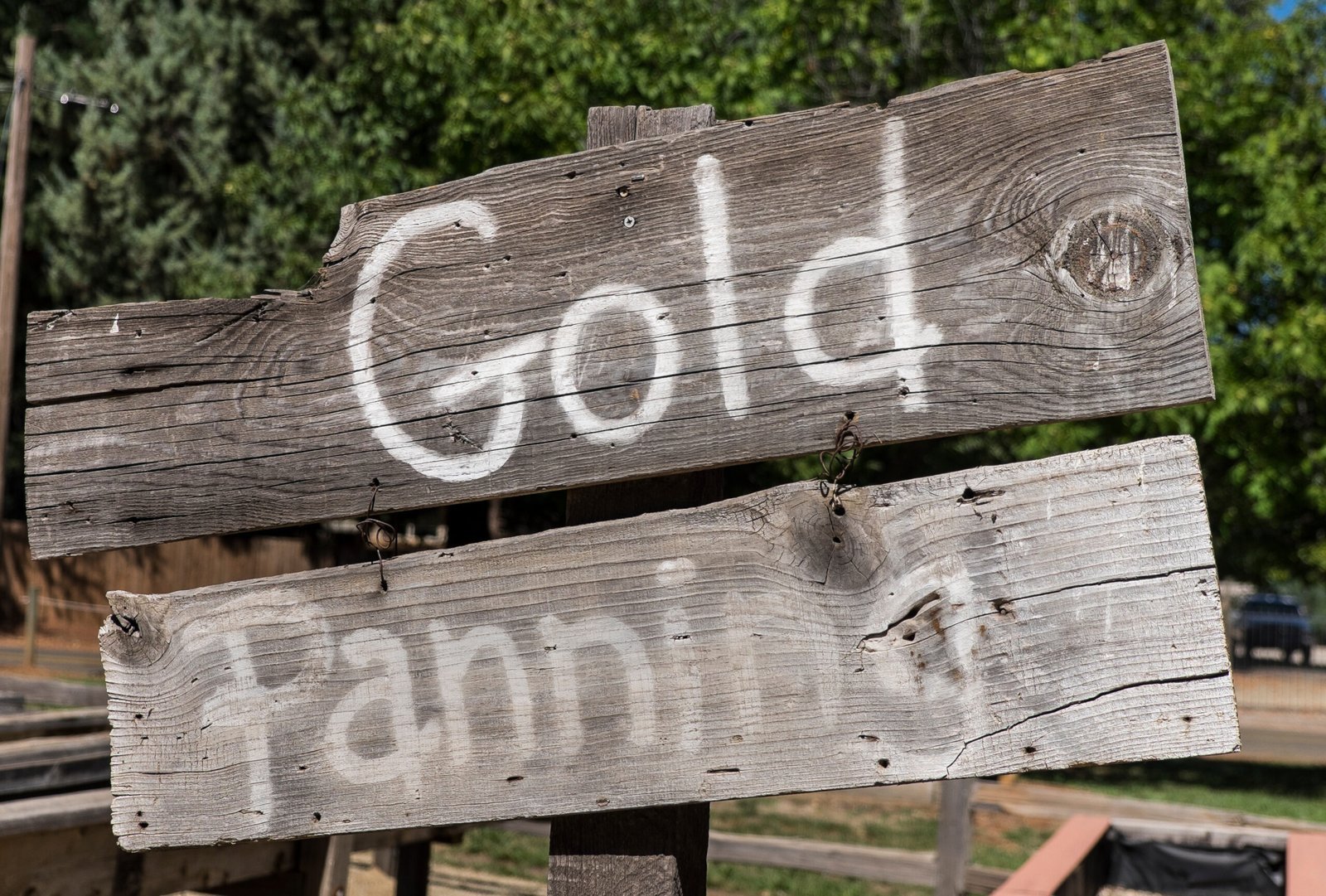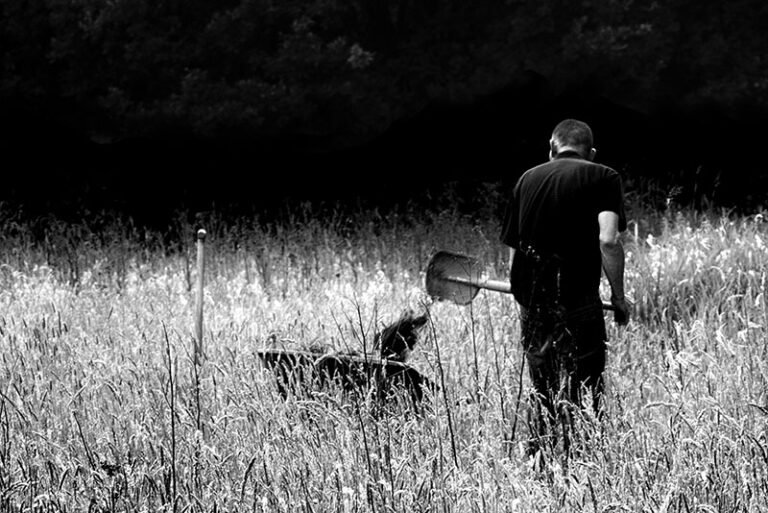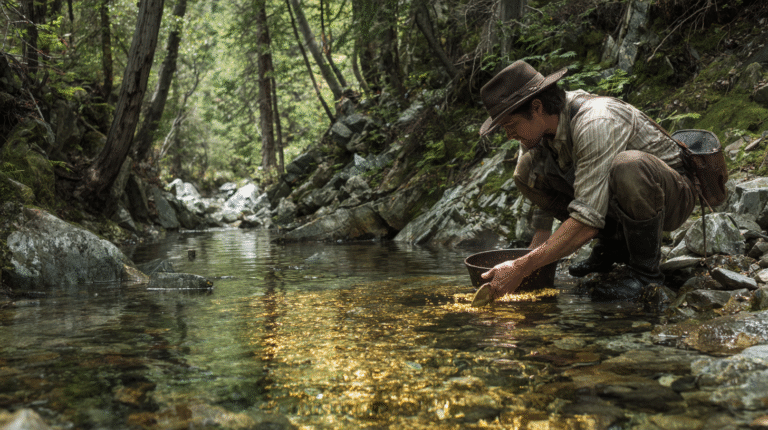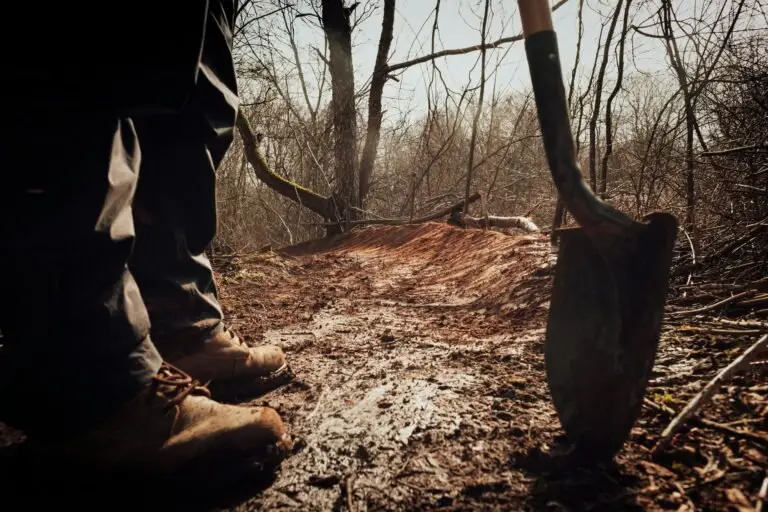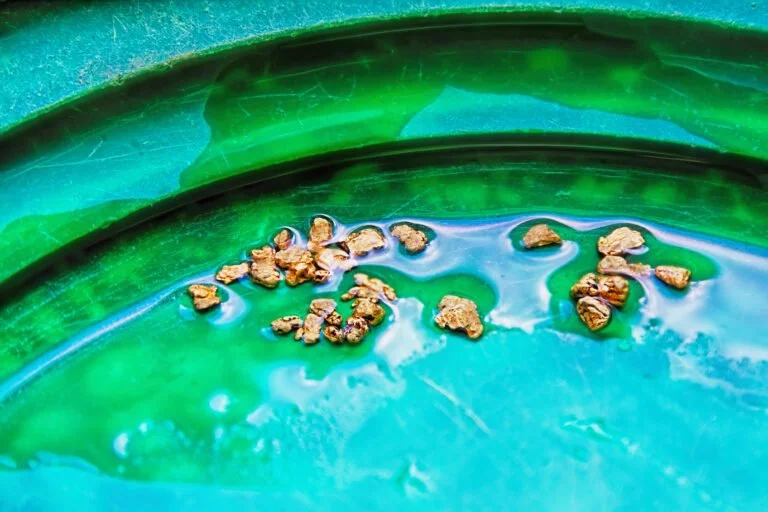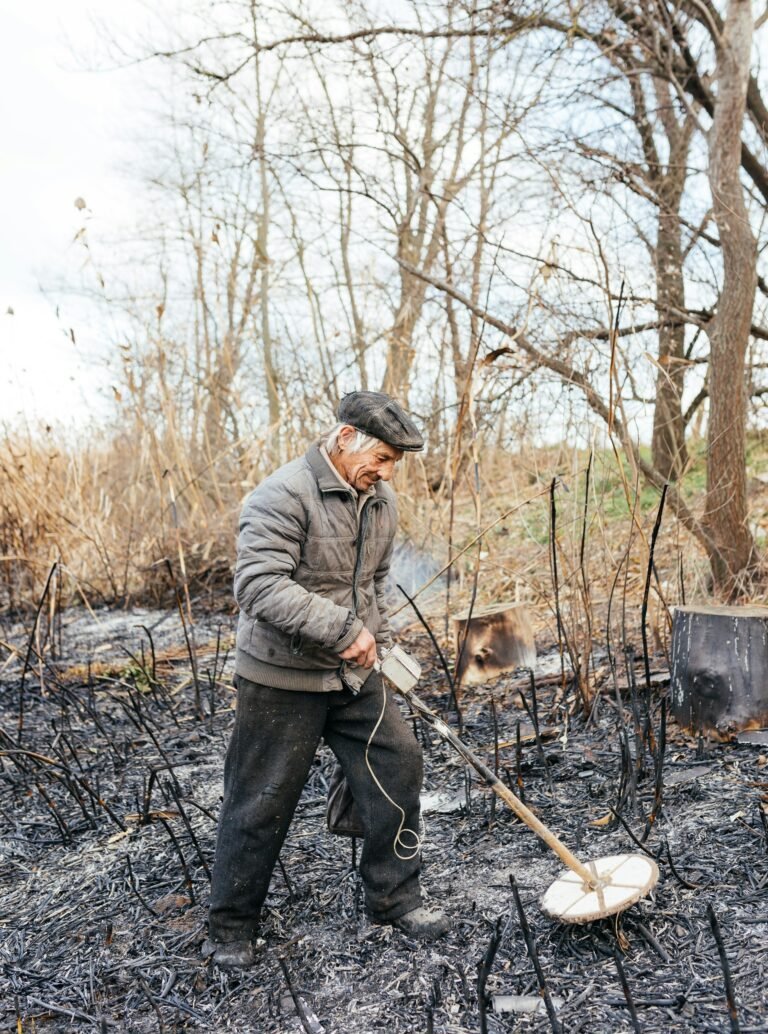Welcome to our comprehensive guide to advanced gold panning techniques!
First Posted July 31, 2025 | Last Updated on September 26, 2025 by Ryan ConlonDisclosure: This Post Contains Affiliate Links; We earn a commission on purchases.
If you’re an avid gold prospector looking to elevate your skills and increase your chances of striking gold, you’ve come to the right place.
In this article, we look at the world of advanced gold panning, covering everything from the equipment you need to where to find gold and how to recognize the real deal.
We will also explore the ethics and strategies behind successful gold panning.
So, let’s jump in and discover the secrets of advanced gold prospecting!
Key Takeaways:
- Advanced gold panning techniques can significantly improve your chances of finding gold.
- Having the right equipment is essential for successful gold panning.
- Researching and identifying gold-rich locations is crucial for effective prospecting.
- Learning how to recognize real gold and avoiding fool’s gold is important.
- Practicing responsible gold panning ethics ensures a sustainable and enjoyable experience.
Equipment you need for gold panning
In order to engage in successful gold panning, it is important to have the right equipment. This includes a gold pan, a shovel, and potentially other tools such as crevicing tools, a river sluice, and a metal detector. Having the proper gear will greatly enhance your gold prospecting experience and increase your chances of finding valuable gold nuggets.
First and foremost, every gold panner needs a reliable gold pan. There are various types available on the market, including metal pans and plastic pans. Metal pans are more durable and better at retaining heat, while plastic pans are lightweight and easier to carry for long periods of time. Some popular gold pan brands include Garrett, Keene, and Fisher. It is recommended to choose a pan with riffles on the side, which help trap the heavier gold particles while washing away the lighter materials.
Another essential tool for gold panning is a sturdy shovel. A long-handled shovel with a pointed or flat blade is ideal for digging in rocky or hard-packed soil. Make sure to choose a shovel made of durable materials, such as steel or fiberglass, to withstand the rigors of gold panning in various terrains.
Depending on your prospecting goals and the specific conditions of your gold panning location, you may also consider investing in additional tools. Crevicing tools, such as small picks and brushes, are useful for extracting gold from narrow crevices or cracks in rocks. A river sluice is a long, narrow box-like tool that uses flowing water to separate gold from other sediments. And a metal detector can be particularly handy for locating gold nuggets buried deep beneath the surface.
To give you a better idea, here is a list of the essential gold panning equipment:
- Gold pan – metal or plastic with riffles
- Shovel – long-handled with a pointed or flat blade
If you are interested in expanding your gear collection, you may also consider:
- Crevicing tools – small picks and brushes
- River sluice – for more efficient gold separation
- Metal detector – for detecting buried gold
Remember that the specific equipment you need may vary depending on your experience level and the type of gold panning you plan to engage in. Beginners can start with a basic gold pan and shovel, while more advanced prospectors may opt for additional specialized tools.
Having the right equipment is the foundation of successful gold panning. With the proper gear, you’ll be well-equipped to embark on your gold prospecting adventures and increase your chances of uncovering that glittering treasure. In the next section, we will discuss where to find gold and the best locations for your gold hunting expeditions.
Where to Find Gold
Knowing where to find gold is essential for successful prospecting. There are various methods you can utilize to research gold mining districts and historical gold locations.
Reaching Out to Local Resources
One effective way to discover gold hunting locations is by connecting with local rock and gem shops. These establishments often have valuable knowledge about nearby areas where gold is likely to be found. They may provide tips, maps, or even offer guided tours to help you in your search.
You can also consider joining prospecting clubs in your area. These clubs regularly organize outings and share insights on the best gold mining districts. Through these communities, you can learn from experienced gold prospectors and gain access to exclusive information about fruitful locations.
Utilizing Online Resources
The internet can be a valuable tool in your quest to find gold. Government geology bulletins are excellent sources for information on gold mining districts. You can find these bulletins online, and they often contain detailed maps, historical data, and prospecting information for various regions.
Another useful online resource is thediggings.com. This website provides a comprehensive database of mining claims, active mines, and gold occurrences across the United States. You can search by location, filter by mining activity, and explore reports and documents related to gold mining.
Surprising Gold Locations
While many people associate gold prospecting with specific regions, it’s important to consider that gold can be found in unexpected places. Indigenous territories in the United States, for example, have historically yielded significant gold deposits.
Additionally, states such as California, Colorado, New Hampshire, and even Iowa have seen gold discoveries over the years. By expanding your search beyond traditional gold mining districts, you might uncover hidden gems.
How to find gold
Once you have identified potential gold hunting locations, it is important to know how to effectively find gold. In this section, we will provide you with valuable tips on how to read a river or creek and identify key areas where gold may be present.
Understanding the characteristics of placer gold
In order to successfully find gold, it is essential to understand the characteristics of placer gold. Placer gold is gold that has been eroded from its original source and found in rivers and creeks. It is heavier than most other materials found in the river, which allows it to settle at the bottom or in crevices.
Recognizing signs of gold deposition
While gold may be present throughout a river, there are certain signs that indicate higher chances of gold deposition. By learning to identify these signs, you can focus your efforts in the most promising areas. Look for areas with slow-moving water, such as behind large rocks or in the inside bends of a river. These areas provide ideal conditions for gold to settle.
Another important factor to consider is the presence of black sands, which often accompany gold deposits. Black sands are heavier minerals that are commonly found with gold. If you spot black sands in a river or creek, it is a good indication that gold may be present nearby.
Prospecting techniques
There are several gold prospecting techniques that can increase your chances of finding gold:
- Crevicing: This technique involves searching for gold in narrow cracks and crevices where it may have settled.
- Sniping: Sniping is the process of using a gravity-fed suction device to extract gold from bedrock cracks and crevices.
- Panning: Panning is a traditional and widely-used method of gold prospecting. It involves using a gold pan to separate gold from gravel and sand by swirling the contents of the pan and tilting it to let the lighter materials wash away.
By combining these prospecting techniques with your understanding of how to read a river, you can significantly increase your chances of finding gold.
| Technique | Description |
|---|---|
| Crevicing | Searching for gold in narrow cracks and crevices |
| Sniping | Using a suction device to extract gold from bedrock cracks and crevices |
| Panning | Separating gold from gravel and sand using a gold pan |
The table above summarizes the different prospecting techniques we discussed and their descriptions. Use these techniques in combination with your river reading skills to optimize your gold panning efforts and increase your chances of finding gold.
Gold vs. Fool’s Gold
Distinguishing between real gold and fool’s gold (iron pyrite) can be a challenge when it comes to gold panning. To avoid potential disappointment and accurately identify valuable gold, it is essential to know how to recognize real gold based on its weight, color, and characteristics.
Real gold holds a distinct advantage over fool’s gold in terms of weight. Gold is significantly denser and heavier than iron pyrite, so if you find a mineral that feels surprisingly light, it is likely fool’s gold. In contrast, genuine gold will have a satisfying weight to it.
Another important factor to consider is color. Real gold has a beautiful, warm yellow hue that sets it apart. On the other hand, fool’s gold often has a brassy, pale yellow color. However, it’s important to note that fool’s gold can sometimes exhibit a color that closely resembles real gold, so relying solely on color can be misleading.
In addition to weight and color, the characteristics of gold can also help identify its authenticity. Genuine gold is highly malleable and can be easily shaped and bent. Fool’s gold, on the other hand, is more brittle and cannot be easily molded.
Remember, the key to identifying real gold lies in a combination of weight, color, and characteristics. By paying attention to these factors, you can ensure that you are accurately identifying valuable gold and avoiding fool’s gold.
| Characteristics | Real Gold | Fool’s Gold (Iron Pyrite) |
|---|---|---|
| Weight | Heavier and denser | Lighter |
| Color | Warm yellow | Brassy, pale yellow |
| Characteristics | Highly malleable | Brittle |
Gold Panning Ethics
As responsible gold panners, it is crucial to prioritize ethics in our pursuit of this precious metal. By following ethical practices, we can protect the environment and ensure the rights of others are respected. Here, we will discuss the importance of responsible gold panning, obtaining permission before prospecting on private land, adhering to regulations on public land, and minimizing environmental impact during gold panning activities.
Obtaining Permission and Following Regulations
Before embarking on any gold panning expedition, it is essential to obtain permission from landowners. Whether you plan to prospect on privately owned land or public land, seeking permission demonstrates respect for the property rights of others and helps maintain positive relationships within the gold panning community. Additionally, it is crucial to familiarize yourself with the regulations governing gold panning in your area. This ensures that you can enjoy this activity in a legal and responsible manner.
Minimizing Environmental Impact
Protecting the natural environment is paramount when engaging in gold panning. Here are some tips to minimize your impact:
- Leave No Trace: Always pack out what you pack in. Dispose of all waste properly, including trash and discarded materials.
- Minimize Disturbance: Be mindful of your surroundings and try to minimize any disturbance to the landscape or natural habitat.
- Reclaim and Restore: If you dig any holes during your prospecting activities, make sure to fill them back in and restore the area as closely as possible to its original state.
- Use Environmentally Friendly Products: Choose gold panning equipment and tools that are designed to minimize environmental harm.
- Support Conservation Efforts: Consider participating in or supporting local conservation initiatives that aim to protect and preserve natural resources.
Responsible gold panning involves not only finding gold but also protecting the environment for future generations of prospectors. By adhering to ethical practices, we can ensure the sustainability of this rewarding activity.
| Ethical Gold Panning Practices | Benefits |
|---|---|
| Obtaining permission before prospecting on private land | Respect for property rights and maintaining positive relationships |
| Adhering to regulations on public land | Ensuring legal and responsible gold panning |
| Minimizing environmental impact | Preserving natural resources and protecting the environment |
| Using environmentally friendly equipment and tools | Reducing harm to the environment |
| Supporting local conservation initiatives | Contributing to the sustainability of gold panning |
How to Read a River
To effectively find gold in rivers, it is crucial to understand the dynamics of the river and how it has transported and deposited gold over time. By mastering the skill of reading a river, you can identify the most promising areas for gold deposition and enhance your chances of success in your gold panning endeavors.
When analyzing a river for gold, it is important to consider various factors, such as areas of high and low pressure, river bends, eddies, and specific features that indicate gold deposition sites. By understanding these dynamics, you can strategically target the areas where gold is most likely to accumulate.
Identifying Areas of High and Low Pressure
One key aspect of reading a river for gold is identifying areas of high and low pressure. Gold is relatively heavy and tends to settle in low-pressure areas where the flow of the river slows down. These areas can typically be found behind large rocks, boulders, or other obstacles in the river.
On the other hand, areas of high pressure, such as fast-moving rapids, are less likely to contain gold deposits. The force of the water in these areas is too strong to allow gold to settle.
Understanding River Bends and Eddies
River bends are another important feature to consider when reading a river for gold. As a river curves, the flow of water changes, causing turbulence. This turbulence creates eddies or swirling currents that can trap sediments, including gold.
By carefully examining river bends and identifying eddies, you can locate potential gold deposition sites. Eddies can be found on the inside of curves, where the water is slower, and at the downstream side of obstructions such as rocks or trees.
Recognizing Features That Indicate Gold Deposition Sites
In addition to areas of high and low pressure and river bends, specific features can indicate gold deposition sites in a river. These features include:
- Gravel bars: Gold tends to settle in gravel bars where the water slows down.
- Bedrock crevices: Gold can become trapped in cracks and crevices in the bedrock.
- Inside bends: As the river flows around inside bends, the outer edge of the river erodes, depositing gold on the inside.
- Benches: Flat areas between a river and its floodplain can contain gold deposits.
By learning to recognize these features and understanding how gold behaves in a river, you can effectively pinpoint gold deposition sites and increase your chances of finding gold while panning.
| Key Features to Consider when Reading a River for Gold |
|---|
| Areas of high and low pressure |
| River bends and eddies |
| Gravel bars |
| Bedrock crevices |
| Inside bends |
| Benches |
How to Pan for Gold
Gold panning is a skill that requires practice and technique. Mastering the art of gold panning can greatly increase your chances of finding precious gold nuggets. In this section, we will guide you through the step-by-step process of panning for gold, using effective techniques to separate the valuable gold from other unwanted materials.
To begin your gold panning journey, make sure you have the necessary equipment: a gold pan, a shovel, and a classifier. These tools will be invaluable as they aid in the separation and extraction of gold.
- Choose your gold panning location: Find a suitable spot along a river or stream where gold is known to occur. Look for areas with slow-moving water that allows gold to settle.
- Fill your gold pan with material: Scoop up a shovelful of sediment from the riverbed and place it into your gold pan. Make sure to remove any large rocks or debris.
- Submerge the gold pan: Immerse the gold pan in the water, tilting it slightly to allow the water to flow into the pan. Continue to hold the pan under the water while gently swirling it in a circular motion.
- Separate the lighter materials: While still swirling the pan in the water, carefully tilt the pan forward. The lighter materials, such as sand and gravel, will be washed away, leaving behind the heavier materials, which may include gold.
- Remove the larger rocks: Once you have removed most of the lighter materials, remove any remaining larger rocks or pebbles from the pan. This will make it easier to spot any gold that may be present.
“Gold panning is a skill that requires patience and attention to detail. The shaking and swirling motions of the pan help separate the heavier gold from the surrounding materials. With practice, you will start to develop a feel for the process and become more efficient in your gold panning technique.”
Separating the gold: Now that you have removed the lighter materials and larger rocks, it’s time to focus on extracting the gold. Use a gentle shaking motion to move the remaining materials from side to side in the pan. This will cause the heavier gold particles to sink to the bottom of the pan.
Removing black sand and concentrates: Black sand, which often contains gold, can be a good indicator of valuable deposits. To remove black sand and concentrates, you can use a technique called “sniping” by gently tapping the edge of the pan near the black sand. This will cause the lighter black sand to be released and washed away, leaving behind the dense gold particles.
Continue this process of shaking, swirling, and removing unwanted materials until only the gold remains. Carefully inspect the bottom of the pan for any glimmers of gold. Use tweezers or a snuffer bottle to collect the precious gold and transfer it to a small vial or container for safekeeping.
Essential Gold Panning Tips
| Tips | Description |
|---|---|
| Practice | The more you practice, the better your gold panning skills will become. Take the time to refine your technique and gain a deeper understanding of the process. |
| Focus on technique | Precision and finesse are key in gold panning. Pay attention to your shaking, swirling, and sifting motions to ensure maximum gold recovery. |
| Stay patient | Finding gold takes time and perseverance. Don’t get discouraged if you don’t strike it rich immediately. Keep practicing and honing your skills. |
| Research your location | Before heading out to pan for gold, research the history of the area and identify potential gold hotspots. This will increase your chances of success. |
Now that you know the gold panning process and have learned important techniques, it’s time to put your skills to the test. Remember, practice makes perfect, and with time and experience, you’ll become a skilled gold panner capable of uncovering valuable treasures.
Equipment Basics
When it comes to gold panning, having the right equipment is essential for success. In this section, we will explore the basics of gold panning equipment and discuss the different tools that every prospector should have.
Gold Pan
The gold pan is perhaps the most important tool in a prospector’s arsenal. It is used to separate the heavy gold particles from the lighter sediments and materials.
“The gold pan is like a partner in your search for treasure. Choose the right one, and it will greatly enhance your chances of success.” – Prospecting expert
There are various types of gold pans available, but the two most common ones are the Garrett Super Sluice and the Proline Blue. Both pans are designed with special features to improve efficiency and gold recovery.
| Gold Pan | Features |
|---|---|
| Garrett Super Sluice |
|
| Proline Blue |
|
Shovel
A sturdy shovel is another essential tool for gold panning. It is used to dig material from the streambed or dig test holes to find potential gold-bearing areas. Look for a shovel that has a strong handle and a durable blade. A folding shovel is a popular option as it can easily fit into your backpack.
Classifier
A classifier is a sifting tool that helps separate the larger rocks and debris from the smaller sediments during the panning process. This ensures that you are working with material that is most likely to contain gold.
“Using a classifier can significantly improve your gold recovery and save you time by reducing the amount of unnecessary material you need to pan.” – Experienced prospector
There are different types of classifiers available, such as mesh screens or plastic pans with built-in classifiers. Choose one that suits your needs and makes the panning process more efficient.
By having the right equipment, including a reliable gold pan, sturdy shovel, and effective classifier, you are setting yourself up for success in your gold panning adventures.
Refining Your Technique
As you gain experience in gold panning, refining your technique is essential to improve your prospecting skills and increase your chances of finding gold. Here are some advanced gold panning techniques to help you take your prospecting to the next level:
Hone Your Observation Skills
One of the key skills to develop as a gold prospector is the ability to observe your surroundings and identify subtle signs of gold. Pay attention to changes in color and texture in the riverbed, as these can indicate the presence of gold. Look for areas where the water flow slows down or changes direction, as gold is often deposited in these spots.
Recognize Subtle Signs of Gold
Gold can sometimes be elusive, so it’s important to know how to recognize its presence even in small quantities. Familiarize yourself with the characteristics of different types of gold, such as fine gold flakes or nuggets. Train your eyes to spot the shimmering yellow color or the metallic luster of gold among the surrounding sediments.
Troubleshoot Common Challenges
While gold panning, you may encounter challenges such as excessive black sand, too much gravel, or difficulties in separating the gold from other materials. Take the time to troubleshoot these issues by experimenting with different techniques and equipment. For example, using a magnet to remove black sand or adjusting the angle and speed of your pan can help you overcome these obstacles.
Remember, refining your gold panning technique takes practice and patience. Don’t get discouraged if you don’t find gold right away. Every session is an opportunity to learn and improve your skills.
By continuously refining your technique and honing your prospecting skills, you will become a more effective and successful gold prospector. With time and experience, you’ll be better equipped to identify and recover gold from even the most challenging panning situations.
| Advanced Gold Panning Techniques | Benefits |
|---|---|
| Honing observation skills | Ability to identify subtle signs of gold |
| Recognizing different types of gold | Improved ability to spot gold in varying forms |
| Troubleshooting common challenges | Overcoming obstacles and maximizing gold recovery |
Conclusion
In conclusion, advanced gold panning techniques can greatly enhance your prospecting skills and increase your chances of successful gold prospecting. By utilizing the right tools and equipment, such as a high-quality gold pan, shovel, and classifier, you can improve the efficiency of your gold panning process.
Knowledge of where to find gold is key, and by researching gold mining districts and historical gold locations, you can hone in on the most promising areas for gold prospecting. Understanding how to read a river and identify potential gold deposition sites will further enhance your ability to find gold.
However, it is crucial to practice responsible and ethical gold panning. Always obtain permission before prospecting on private land and adhere to regulations when exploring public land. By minimizing your impact on the environment and respecting the rights of others, you can preserve the natural beauty of gold-bearing areas for future generations of prospectors.
With the right tools, knowledge, technique, and a determined mindset, you can embark on your gold prospecting journey with confidence. Put your advanced gold panning techniques to work, and may you strike gold in your pursuit of this precious metal.
Source Links
- https://www.treelinereview.com/learn-skills/get-started-gold-prospecting
- https://seriousdetecting.com/pages/library__best-gold-panning-guide
- https://www.goldprospectors.org/Forum/aft/4400

Meet Ryan Conlon, the passionate owner and driving force behind Pan for Treasure.
With an unwavering love for the art of gold panning, Ryan has transformed his enthusiasm into a thriving community hub for fellow treasure seekers. info@panfortreasure.com
A seasoned gold panning enthusiast, Ryan’s journey began with a simple pan and a dream, evolving into a deep appreciation for the history, geology, and thrill of uncovering precious metals.
Subscribe to Our Newsletter

